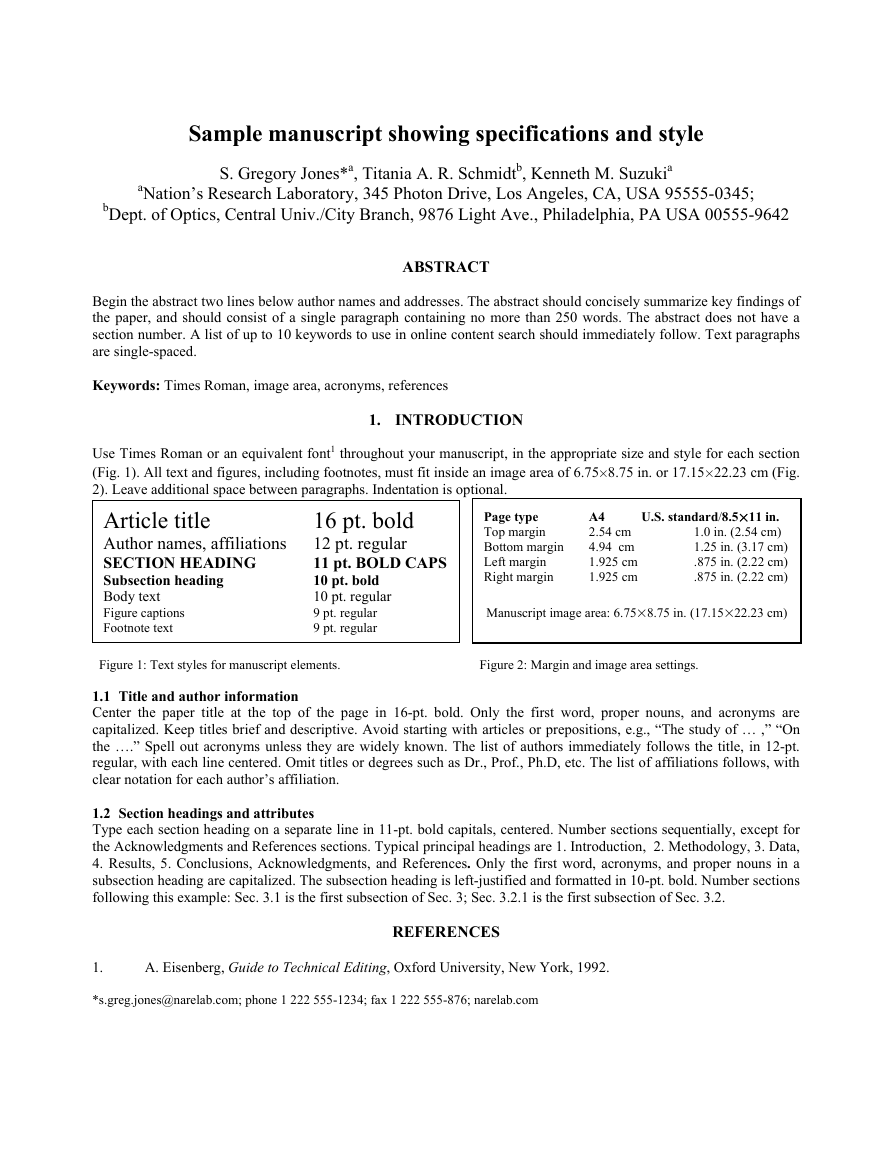Sample manuscript showing specifications and style
S. Gregory Jones*a, Titania A. R. Schmidtb, Kenneth M. Suzukia
aNation’s Research Laboratory, 345 Photon Drive, Los Angeles, CA, USA 95555-0345;
bDept. of Optics, Central Univ./City Branch, 9876 Light Ave., Philadelphia, PA USA 00555-9642
ABSTRACT
Begin the abstract two lines below author names and addresses. The abstract should concisely summarize key findings of
the paper, and should consist of a single paragraph containing no more than 250 words. The abstract does not have a
section number. A list of up to 10 keywords to use in online content search should immediately follow. Text paragraphs
are single-spaced.
Keywords: Times Roman, image area, acronyms, references
1. INTRODUCTION
U.S. standard/8.5×11 in.
A4
1.0 in. (2.54 cm)
2.54 cm
1.25 in. (3.17 cm)
4.94 cm
1.925 cm
.875 in. (2.22 cm)
.875 in. (2.22 cm)
1.925 cm
16 pt. bold
12 pt. regular
11 pt. BOLD CAPS
10 pt. bold
10 pt. regular
9 pt. regular
9 pt. regular
Page type
Top margin
Bottom margin
Left margin
Right margin
Manuscript image area: 6.75×8.75 in. (17.15×22.23 cm)
Use Times Roman or an equivalent font1 throughout your manuscript, in the appropriate size and style for each section
(Fig. 1). All text and figures, including footnotes, must fit inside an image area of 6.75×8.75 in. or 17.15×22.23 cm (Fig.
2). Leave additional space between paragraphs. Indentation is optional.
Article title
Author names, affiliations
SECTION HEADING
Subsection heading
Body text
Figure captions
Footnote text
Figure 1: Text styles for manuscript elements.
1.1 Title and author information
Center the paper title at the top of the page in 16-pt. bold. Only the first word, proper nouns, and acronyms are
capitalized. Keep titles brief and descriptive. Avoid starting with articles or prepositions, e.g., “The study of … ,” “On
the ….” Spell out acronyms unless they are widely known. The list of authors immediately follows the title, in 12-pt.
regular, with each line centered. Omit titles or degrees such as Dr., Prof., Ph.D, etc. The list of affiliations follows, with
clear notation for each author’s affiliation.
1.2 Section headings and attributes
Type each section heading on a separate line in 11-pt. bold capitals, centered. Number sections sequentially, except for
the Acknowledgments and References sections. Typical principal headings are 1. Introduction, 2. Methodology, 3. Data,
4. Results, 5. Conclusions, Acknowledgments, and References. Only the first word, acronyms, and proper nouns in a
subsection heading are capitalized. The subsection heading is left-justified and formatted in 10-pt. bold. Number sections
following this example: Sec. 3.1 is the first subsection of Sec. 3; Sec. 3.2.1 is the first subsection of Sec. 3.2.
Figure 2: Margin and image area settings.
A. Eisenberg, Guide to Technical Editing, Oxford University, New York, 1992.
1.
*s.greg.jones@narelab.com; phone 1 222 555-1234; fax 1 222 555-876; narelab.com
REFERENCES
�


 2023年江西萍乡中考道德与法治真题及答案.doc
2023年江西萍乡中考道德与法治真题及答案.doc 2012年重庆南川中考生物真题及答案.doc
2012年重庆南川中考生物真题及答案.doc 2013年江西师范大学地理学综合及文艺理论基础考研真题.doc
2013年江西师范大学地理学综合及文艺理论基础考研真题.doc 2020年四川甘孜小升初语文真题及答案I卷.doc
2020年四川甘孜小升初语文真题及答案I卷.doc 2020年注册岩土工程师专业基础考试真题及答案.doc
2020年注册岩土工程师专业基础考试真题及答案.doc 2023-2024学年福建省厦门市九年级上学期数学月考试题及答案.doc
2023-2024学年福建省厦门市九年级上学期数学月考试题及答案.doc 2021-2022学年辽宁省沈阳市大东区九年级上学期语文期末试题及答案.doc
2021-2022学年辽宁省沈阳市大东区九年级上学期语文期末试题及答案.doc 2022-2023学年北京东城区初三第一学期物理期末试卷及答案.doc
2022-2023学年北京东城区初三第一学期物理期末试卷及答案.doc 2018上半年江西教师资格初中地理学科知识与教学能力真题及答案.doc
2018上半年江西教师资格初中地理学科知识与教学能力真题及答案.doc 2012年河北国家公务员申论考试真题及答案-省级.doc
2012年河北国家公务员申论考试真题及答案-省级.doc 2020-2021学年江苏省扬州市江都区邵樊片九年级上学期数学第一次质量检测试题及答案.doc
2020-2021学年江苏省扬州市江都区邵樊片九年级上学期数学第一次质量检测试题及答案.doc 2022下半年黑龙江教师资格证中学综合素质真题及答案.doc
2022下半年黑龙江教师资格证中学综合素质真题及答案.doc